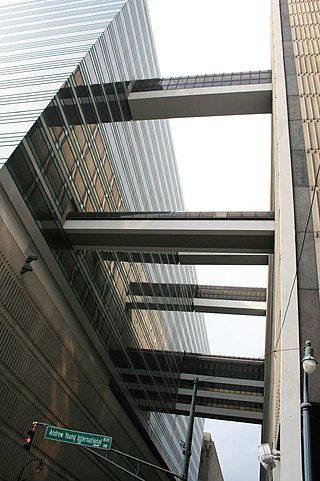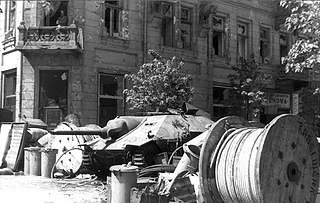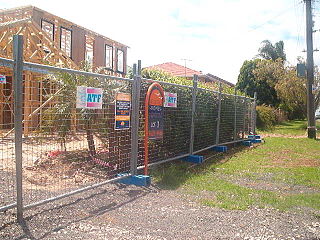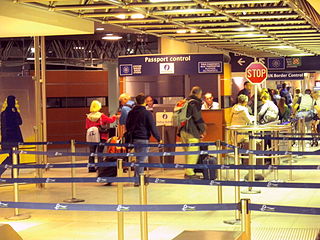
Gaspard-Félix Tournachon, known by the pseudonym Nadar, was a French photographer, caricaturist, journalist, novelist, balloonist, and proponent of heavier-than-air flight. In 1858, he became the first person to take aerial photographs.

A skyway, skybridge, skywalk, or sky walkway is an elevated type of pedway connecting two or more buildings in an urban area, or connecting elevated points within mountainous recreational zones. Urban skyways very often take the form of enclosed or covered footbridges that protect pedestrians from the weather. Open-top modern skyways in mountains now often have glass bottoms. Sometimes enclosed urban skywalks are made almost totally from glass, including ceilings, walls and floors. Also, some urban skyways function strictly as linear parks designed for walking.

Victor Pierre Horta was a Belgian architect and designer, and one of the founders of the Art Nouveau movement. He was a fervent admirer of the French architectural theorist Eugène Viollet-le-Duc and his Hôtel Tassel in Brussels (1892–93), often considered the first Art Nouveau house, is based on the work of Viollet-le-Duc. The curving stylized vegetal forms that Horta used in turn influenced many others, including the French architect Hector Guimard, who used it in the first Art Nouveau apartment building he designed in Paris and in the entrances he designed for the Paris Metro. He is also considered a precursor of modern architecture for his open floor plans and his innovative use of iron, steel and glass.

A water cannon is a device that shoots a high-velocity stream of water. Typically, a water cannon can deliver a large volume of water, often over dozens of meters. They are used in firefighting, large vehicle washing, riot control, and mining. Most water cannons fall under the category of a fire monitor.

The City of Brussels is the largest municipality and historical centre of the Brussels-Capital Region, as well as the capital of the Flemish Region and Belgium. The City of Brussels is also the administrative centre of the European Union, as it hosts a number of principal EU institutions in its European Quarter.

The Hong Kong Economic and Trade Offices (HKETOs) are the trade offices of Hong Kong outside the territory. There are 14 HKETOs outside Hong Kong and China, and seven in China.

Barricade is any object or structure that creates a barrier or obstacle to control, block passage or force the flow of traffic in the desired direction. Adopted as a military term, a barricade denotes any improvised field fortification, such as on city streets during urban warfare.

Crowd control is a public security practice in which large crowds are managed in order to prevent the outbreak of crowd crushes, affray, fights involving drunk and disorderly people or riots. Crowd crushes in particular can cause many hundreds of fatalities. Effective crowd management is about managing expected and unexpected crowd occurrences. Crowd control can involve privately hired security guards as well as police officers. Crowd control is often used at large, public gatherings like street fairs, music festivals, stadiums and public demonstrations. At some events, security guards and police use metal detectors and sniffer dogs to prevent weapons and drugs being brought into a venue.

A stanchion is a sturdy upright fixture that provides support for some other object. It can be a permanent fixture.

Temporary fencing is a free standing, self-supporting fence panel. The panels are held together with couplers that interlock panels together making it portable and flexible for a wide range of applications. A common type of temporary fencing is Heras fencing.

The men's épée was a fencing event held as part of the Fencing at the 1912 Summer Olympics programme. It was the fourth appearance of the event, which had been introduced in 1900. The competition was held from 11 to 13 July at the Östermalm Athletic Grounds. There were 93 competitors from 15 nations. Each nation could enter up to 12 fencers. The event was won by Paul Anspach of Belgium. His countryman Philippe le Hardy took bronze. Silver went to Denmark's Ivan Joseph Martin Osiier, the only medal won by the perennial Olympian who competed in seven Games over 40 years. The medals were the first in the men's épée for both nations.

Paul Eugène Albert Anspach was a Belgian épée and foil fencer who competed in four consecutive Olympics.
Henri Lucien Ernest Eugène Anspach was a Belgian épée and foil fencer. He was an Olympic champion in team épée.

The covering of the Senne was the covering and later diverting of the main river of Brussels, Belgium, and the construction of public buildings and major boulevards in its place. Carried out between 1867 and 1871, it is one of the defining events in the history of Brussels.

The Boulevard Anspach (French) or Anspachlaan (Dutch) is a central boulevard in Brussels, Belgium, connecting the Place de Brouckère/De Brouckèreplein to the Place Fontainas/Fontainasplein. It was created following the covering of the river Senne (1867–1871), and bears the name of Jules Anspach, a former mayor of the City of Brussels.
The men's team foil was one of eight fencing events on the fencing at the 1984 Summer Olympics programme. It was the sixteenth appearance of the event. The competition was held from 4 to 5 August 1984. 65 fencers from 14 nations competed.

Juxtaposed controls are a reciprocal arrangement between Belgium, France, the Netherlands and the United Kingdom whereby border controls on certain cross-Channel routes take place before boarding the train or ferry, rather than upon arrival after disembarkation. With the exception of the Eurotunnel Shuttle route, customs checks remain unaffected by juxtaposed immigration controls and continue to take place upon arrival after disembarkation. Belgium, France and the Netherlands are all member states of the European Union and part of the border-free Schengen Area. The United Kingdom, on the other hand, has never participated in the Schengen Area, even when it was a member state of the European Union. As a result, juxtaposed controls aim to increase the convenience and efficiency of border checks when travelling by train or ferry between the Schengen Area and the UK by removing the need for immigration checks on arrival and by streamlining checks on departure. At the same time, juxtaposed controls are intended to detect and prevent illegal immigration. In 2016, there were over 56,000 instances when people were refused entry to the UK at the juxtaposed controls.

A series of sit-in street protests, often called the Umbrella Revolution and sometimes used interchangeably with Umbrella Movement, or Occupy Movement, occurred in Hong Kong from 26 September to 15 December 2014.

The Place de la Bourse (French) or Beursplein (Dutch), meaning "Stock Exchange Square", is a major square in central Brussels, Belgium. It was created following the covering of the river Senne (1867–1871). The former Brussels Stock Exchange building, of which it takes its name, is located on this square. It is served by the premetro station Bourse/Beurse on lines 3 and 4.



















